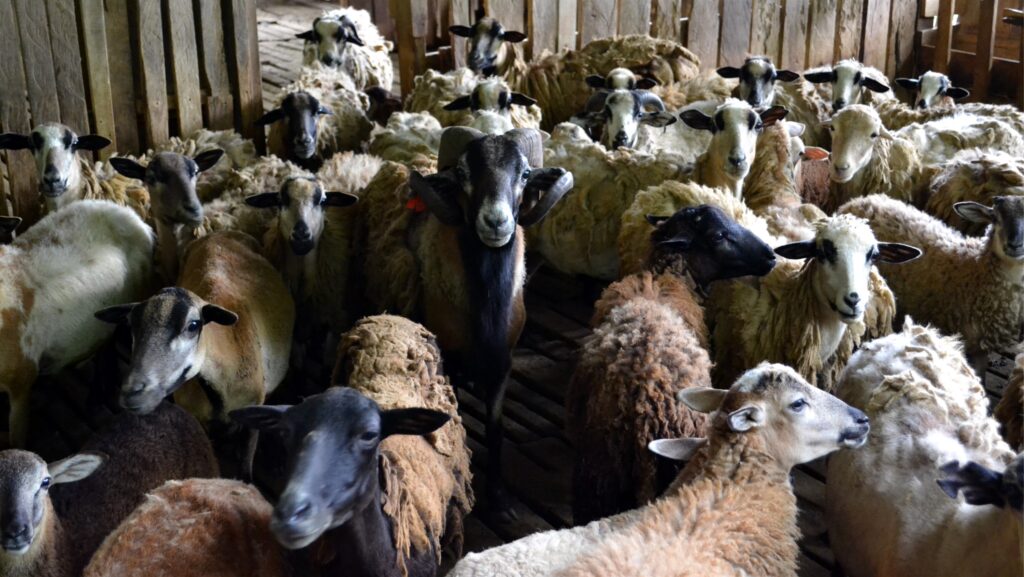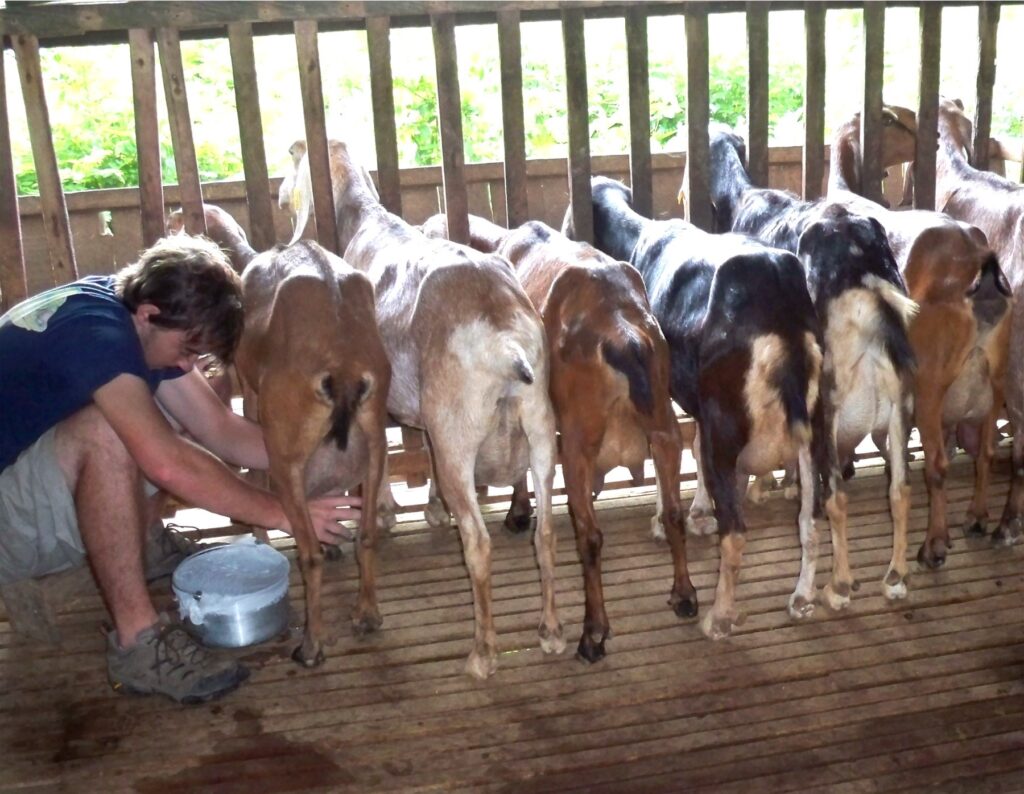Text and Photos by Henrylito D. Tacio
Ruminants — the world ruminant comes from the Latin “ruminare,” which means “to chew over again” — are mammals that are able to acquire nutrients from plant-based food by fermenting it in a specialized stomach prior to digestion, principally through bacterial actions.
In the Philippines, two of the most popular small ruminants are goats and sheep. Both are part of farming in the country. But among these two, goats are on the top list.
“Goats are very popular among Filipinos because they require low initial capital investment, fit the smallhold farm conditions, and multiply fast,” explained the Laguna-based Philippine Council for Agriculture, Aquatic, Forestry, and Natural Resources Research and Development (PCAARRD) in its investment briefer. “Culturally, goats are integral to every special occasion such as birthdays, baptisms, weddings, and fiestas. Hence, they command a higher price compared with other meats in the market.”
Goats require low maintenance because they eat tree leaves, grasses, weeds, and agricultural by-products. “Goats require less feed than cows and carabaos,” said Jethro P. Adang, director of the Davao-based Mindanao Baptist Rural Life Center (MBRLC) Foundation, Inc.
About ten native goats can be fed on the feedstuffs sufficient for one cattle. And about 6-7 purebred dairy goats can be fed on the feedstuffs adequate for one dairy cow. “Although a goat is small, she can produce as much as four liters of milk a day if she is purebred and is given a ration to meet all of her nutritional requirements,” Adang said.

In a study conducted by a government agency, it was found out that goats are multi-purpose ruminants producing 58.4% milk, 35.6% meat, and 4.3% hide, and 1.7% fiber. According to them, these small ruminants can provide the answer to improve nutritional requirements of the predominantly rural farm families scattered all over the archipelago.
As goat production requires low initial investment and small risks compared to other livestock, it is, therefore, an attractive undertaking among resource-poor families. In addition, women and children can raise the animals, making it a sound option to augment the country’s programs on livelihood. Goats provide a livelihood to about 15 million Filipinos across the country, according to PCARRD.
In Mindanao, goat farming is considered a “sunshine industry.” The country’s second-largest island has a large Muslim population, and goat meat is considered Halal food. There is also a big demand in the international market, particularly the Middle East.
In Davao City, more and more people are raising goats on their farms. Take the case of Darwin Tinasas, a young marine engineering graduate who decided to raise goats as his main business. He does not only raise goats on his own farm, but he also disperses breeders to farmers who would like to raise the ruminants.

Aside from providing him a steady income from the milk and sales of breeding stocks, he discovered one thing about the animals. “Their manure is a good source of fertilizer,” he said. His stock of about 300 goats provides organic fertilizer for his four farms in Davao City. He plants rice and grows pomelo, coconuts, durian, and other fruits on 30 hectares.
The popularity of raising goats has given the MBRLC an impetus to develop a farming system that integrates goat raising into its original Sloping Agricultural Land Technology (SALT 1). It is called Simple Agro-Livestock Technology or SALT 2.
Under the SALT 2 scheme, 40 percent of the farm’s land is devoted to agricultural crops (like citrus, black pepper, beans, and corn), 40 percent to livestock (mainly goats), and 20 percent to forestry (mostly fruit trees and various nitrogen-fixing trees and shrubs).
“Our model farm is only one-half hectare,” says Adang. Instead of raising cattle, which requires a land area of one hectare per animal, MBRLC recommends goats. “Although a goat is small, she can produce as much as four liters of milk every day if she is purebred and is given a ration to meet all of her nutritional requirements,” he says.

In SALT 2, 12 does, and one buck is raised. The buck is separated from the does so that when it is time to milk the does, the milk won’t “catch” the “goaty smell” of the buck. During breeding, a doe is brought to the cottage of the buck. The manure is utilized as fertilizer for the forage and the crops.
As it follows the original SALT system, hedgerows of various nitrogen-fixing trees are planted all over the farm. At the lower portion, more forage crops are planted. The forages and hedgerows are cut every now and then, and the cuttings are used as feed for goats.
The goat manure is utilized as fertilizer for the forages and agricultural crops (which are planted at the upper portion of the farm). Studies have shown that goat manure contains 1.5 percent of nitrogen, 1.2 percent of potassium, and 0.5 percent phosphorus.
There is money in goat’s milk. “With fresh goat’s milk, you can be sure that the milk your child is taking is free from harmful chemicals,” Adang declares.
Another small ruminant that Filipinos should take a closer look at his sheep. “The animals are generally held in low esteem,” wrote Dr. Jose Rizal in 1903. Sadly, this observation of the country’s national hero still holds true even today.

What’s the reason for the underdevelopment of the sheep industry in the Philippines despite the animal’s enormous economic potential?
“Sheep as a commodity had very low priority as far as research and development were concerned,” explained Dr. Patricio Faylon when he was still the director of the PCAARRD’s Livestock Research Division.
Sheep and goats are closely related as both are in the subfamily Caprinae. But they are separate species, so hybrids rarely occur and are always infertile. A hybrid of a ewe and a buck (a male goat) is called a sheep-goat hybrid (only a single such animal has been confirmed).
In the Philippines, sheep have a long history. It was introduced here during the Spanish era. In fact, the sheep we call “native” today is really the Spanish Merino brought to the country by the Spaniards during the Galleon Trade between Mexico and the Philippines.
Raising sheep became quite popular by the mid-1930s. But due to the breeders’ lack of knowledge on the scientific rearing of the sheep, the health of the country’s stock deteriorated, and the population dwindled steadily. Animal experts are urging Filipinos to raise more sheep. It’s a better animal to raise than a goat, they claim.
What are the advantages of raising sheep over other animals, particularly goats? According to some farmers, sheep are among the most productive and economic animals that Filipinos can raise. One farmer even compared the two small ruminants: “The goats were unruly, ate the bark of my trees, and did not multiply enough. On the other hand, the sheep are quiet, docile, and multiply rapidly.”
Unlike goats, which are browsing animals, sheep are grazers that like to feed on short grass. Sheep are incredibly hardy animals that can survive with little or no care. Newborn lambs, for instance, do not need any human intervention to survive. The only care practiced by some sheep farmers on the newborn is to apply a tincture of iodine on their navel to prevent infection of the umbilical cord.
Sheep have been found to be more resistant to parasites, both internal and external, and respiratory diseases than goats. They can, in addition, better stand inclement weather, including typhoons. Sheep, even those with a low dressing percentage, can produce more meat than goats.
“Since mutton (the sheep of the meat) can replace beef, carabeef, or pork in the Filipino diet, sheep production on a granted scale at the backyard level by millions of small farmers could help meet the people’s increasing need for quality meat and meat products,” Alimoane said.
Nilo Casas is an avid goat raiser who is very much convinced that there is money in raising sheep. He maintains two sheep and goat farms. One is an 18-hectare farm in Masbate, and the other, a smaller 5-hectare farm in Kawit, Cavite, where all his ruminants roam freely to pasture in verdant grasslands.
According to him, the demand peaks for sheep are during Christmas and Muslim holidays and when the Arab communities in the Philippines have their own celebrations. For Arabs, Casas said they buy only live sheep from him, and they want it complete with ears and tail.
Another market is the growing number of overseas-based Filipino engineers who have already acquired the habit of cooking and eating mutton, which they have acquired during the years they have stayed in various Arab countries.

